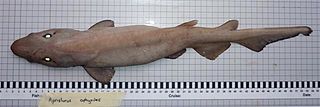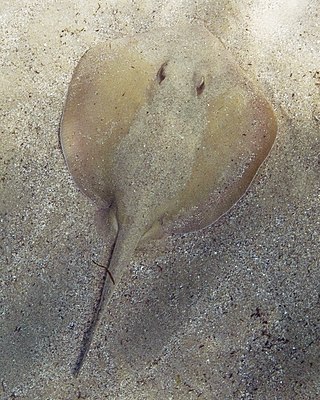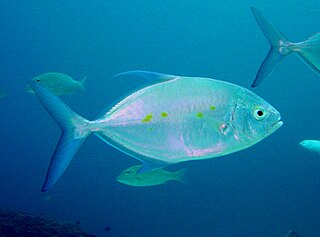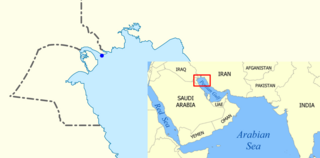
The sixgill stingray is a species of stingray and the only extant member of the family Hexatrygonidae. Although several species of sixgill stingrays have been described historically, they may represent variations in a single, widespread species. This flabby, heavy-bodied fish, described only in 1980, is unique among rays in having six pairs of gill slits rather than five. Growing up to 1.7 m (5.6 ft) long, it has a rounded pectoral fin disc and a long, triangular, and flexible snout filled with a gelatinous substance. It is brownish above and white below, and lacks dermal denticles.

The blotchy swellshark or Japanese swellshark is a common species of catshark, belonging to the family Scyliorhinidae. The Blotchy swellshark is found at depths of 90–200 m (300–660 ft) in the northwestern Pacific Ocean, from Japan to Taiwan. It is benthic in nature and favors rocky reefs. Reaching 1.4 m (4.6 ft) in length, this thick-bodied shark has a broad head, large mouth, and two unequally-sized dorsal fins positioned far back past the pelvic fins. It can be identified by its dorsal coloration, consisting of seven brown "saddles" and extensive darker mottling on a light tan background. This species has often been confounded with the draughtsboard shark and the Sarawak pygmy swellshark in scientific literature.

The largetooth cookiecutter shark is a rare species of squaliform shark in the family Dalatiidae, reported from depths of 60–200 m (200–660 ft) at scattered locations in the Atlantic and Pacific Oceans. As its common name suggests, it is similar in appearance to the cookiecutter shark but has much larger lower teeth. This species reaches a maximum known length of 42 cm (17 in). The largetooth cookiecutter shark feeds by gouging out chunks of flesh from larger animals, including bony fishes, sharks, and marine mammals, and is able to take larger bites than I. brasiliensis. Little is known of its life history; it is thought to be a weaker swimmer than I. brasiliensis, and is presumably aplacental viviparous like the rest of its family. This shark is an infrequent bycatch of commercial trawl and longline fisheries, but is not thought to be much threatened by these activities.

The banded houndshark is a species of houndshark in the family Triakidae, common in the northwestern Pacific Ocean from the southern Russian Far East to Taiwan. Found on or near the bottom, it favors shallow coastal habitats with sandy or vegetated bottoms, and also enters brackish water. This shark reaches 1.5 m (4.9 ft) in length. It has a short, rounded snout and mostly narrow fins; the pectoral fins are broad and triangular, and the trailing margin of the first dorsal fin is almost vertical. It is gray above and lighter below; younger sharks have darker saddles and dots, which fade with age.

The quagga catshark is a species of catshark, belonging to the family Scyliorhinidae. A small, slim-bodied shark reaching 37 cm (15 in) in length, it has a distinctive color pattern of narrow, dark brown vertical bars, which resemble those of the quagga. Its head is short and flattened, with a pointed snout tip that is not upturned.

The white ghost catshark is a shark of the catshark family Scyliorhinidae found in deep water in the northeast Atlantic between latitudes 57°N and 58°N. A deep-water catshark known from the eastern North Atlantic from depths of 1,014 to 1,800 m, it is known from only a limited number of specimens. It reaches a maximum of 54 cm or 1.7 ft total length which is a medium size for the Apristurus genus.

The Taiwan angelshark is an angelshark in the family Squatinidae. The Taiwan angelshark is one of four species of Squatina in the waters around Taiwan and Japan. It is a demersal, ray-like shark that grows to 1–2 meters in length.

The Florida torpedo is a rare and little-known species of electric ray in the family Torpedinidae. It is known only from two specimens and a some wild sightings. Torpedoes have been recorded from three scattered locations in the Florida Straits and the western Caribbean Sea, and appear to inhabit coral habitats.

The common stingaree is a species of stingray in the family Urolophidae. The most abundant ray in inshore waters off eastern Australia, it generally inhabits estuaries, sandy flats, and rocky reefs from the shore to a depth of 60 m (200 ft). This plain brownish to grayish species has a rounded pectoral fin disc with a broadly triangular snout. Its nostrils have enlarged lobes on their outer margins and a skirt-shaped curtain of skin with a fringed posterior margin between them. Its tail bears a small dorsal fin before the stinging spine, and terminates in a leaf-shaped caudal fin. This ray can grow to 52 cm (20 in) long.

The shrimp scad, is a species of widespread tropical marine fish of the jack family, Carangidae. The shrimp scad is widely distributed in the tropical and subtropical western Indian Ocean and areas of the eastern Pacific Ocean, ranging from South Africa in the west to Hawaii in the east, including Japan and Australia to the north and south. The species is commonly found on inshore reefs and sandy substrates. It has the common body profile of a scad, and may be difficult to differentiate from others in the genus Alepes. It is one of the larger scads, growing to 40 cm, but often is encountered at much smaller sizes. The shrimp scad often forms large schools, and is carnivorous, consuming a variety of crustaceans and small fish. It is of moderate importance to fisheries throughout its range.

The rainbow runner, also known as the rainbow yellowtail, Spanish jack and Hawaiian salmon, is a common species of pelagic marine fish of the jack family, Carangidae. The species is widespread throughout the tropical and subtropical waters of the world, inhabiting both coastal and offshore areas. The species is the only member of the genus Elagatis, which was created 15 years after its initial description, and is closely related to the amberjacks. The rainbow runner is easily distinguished by its body shape, and the brilliant colouration which gives the fish its name. It is a fast-swimming predator, taking small fish, cephalopods, and a wide variety of planktonic crustaceans. The species reaches sexual maturity around 60 cm (24 in), and spawning takes place at different times, with some populations spawning year round, while others only spawn at certain times of the year. The species is a well known game fish, taken by a variety of fishing methods, and is a well-regarded table fish. Large numbers of the species are taken as bycatch in tuna- and shark-fishing operations and marketed.

The coastal trevally, also known as the onion trevally, Japanese trevally or bluefin kingfish, is a species of inshore marine fish in the jack family Carangidae. The species is distributed throughout the tropical and subtropical waters of the Indian and west Pacific Oceans, from South Africa in the west to Japan and New Caledonia in the east, reaching as far south as Australia. The species is found on deep coastal reefs, both in schools and as solitary individuals, where they prey on small midwater organisms including crustaceans, small fish and cephalopods. The species is taken as bycatch in a number of fisheries throughout its range by a number of fishing methods and is of little commercial value, but is considered to be a good table fish. A mistype in the original volume in which Eduard Rüppell named the species led to the combination Carangoides caeruleopinnatus, which has incorrectly spread through the literature.

The finless sleeper ray is a species of electric ray in the family Narkidae, and the sole member of its genus. It is found over the continental shelf of Southeast Asia from the eastern Andaman Sea to Vietnam and Borneo. Typically growing no more than 15 cm (5.9 in) long, it may be the smallest cartilaginous fish. The finless sleeper ray is the only electric ray that lacks dorsal fins. It has an oval pectoral fin disc that varies from longer than wide to wider than long, depending on age, and a short, robust tail that terminates in a short, deep caudal fin. The trailing margins of its pelvic fins are sexually dimorphic, being more concave in males.

The island trevally, island jack, thicklip trevally or false bluefin trevally is a widespread species of offshore marine fish classified in the jack family Carangidae. The island trevally is common through the tropical regions of the Indian and Pacific Oceans, ranging from Mozambique and the Seychelles in the west to Hawaii and the Revillagigedo Islands in the central and eastern Pacific. The species is almost completely absent from the continental shelves, instead inhabiting offshore islands, where it is found in lagoons and on reef systems. It is a moderately large fish, growing to a maximum recorded length of 75 cm and 6.6 kg in weight, and is distinguishable by its angular snout and yellow spots, as well as more detailed anatomical features. The island trevally often moves in small schools, preying on a variety of small fishes and crustaceans. It is of moderate importance to fisheries throughout its range, often taken by trawls, hook-and-line, and various inshore netting methods, and is sold fresh or salted at market.

The mottled skate is a species of skate in the family Rajidae. An inhabitant of shallow coastal waters, it is found in the northwestern Pacific Ocean off Korea, Japan, and China. This species grows to 1.12 m (3.7 ft) long and has a diamond-shaped pectoral fin disc with a long snout. It is characterized by a covering of prickles above and below its snout, but not elsewhere on its body, and a dark ring in the middle of each "wing".

The Indonesian angelshark is a rare species of angelshark, family Squatinidae, known only from a few specimens collected from fish landing sites in southern Indonesia. It is thought to inhabit the deep waters of the continental slope. Reaching at least 1.34 m (4.4 ft) long, this species has a flattened, ray-like shape and a well-developed tail and caudal fin. It is characterized by the absences of fringes on its nasal barbels and thorns down the midline of its back, as well as by its relatively plain grayish-brown dorsal coloration with dark saddles beneath the dorsal fin bases and a black leading margin on the underside of the pectoral fins. The International Union for Conservation of Nature (IUCN) has classified it as Critically Endangered due to significant fishing pressure.

The pita skate is a medium-sized skate in the family Rajidae. The holotype and only known specimen was found in the northern Persian Gulf, in Iraqi waters. It was collected at a depth of less than 15 m (49 ft).

The longrakered trevally, also known as the cale cale trevally and heavyjawed kingfish, is a species of marine fish in the jack and horse mackerel family Carangidae. The longrakered trevally is distributed throughout the tropical and subtropical waters of the Indian and west Pacific Oceans, from Mozambique and Madagascar in the west, to Japan and northern Australia in the east. A large species growing to a recorded length of 1 m, the longrakered trevally is distinguished by is protruding lower jaw, elongated gill rakers and lack of villiform teeth on its tongue. It is an inshore species, restricted to coastal and estuarine regions, where it preys on fishes and crustaceans. Little is known of the species reproductive cycle or growth. The longrakered trevally is of minor importance to fisheries and is often taken as bycatch in finfish and prawn trawls, as well as by recreational fishermen.

Trachyrincus scabrus, the roughsnout grenadier or Mediterranean longsnout grenadier, is a species of bathydemersal marine fish from the subfamily Trachyrincinae, part of the family Macrouridae. It is found in the eastern Atlantic Ocean and the Mediterranean.

Benthobatis moresbyi, commonly known as the dark blindray, dark blind ray, or the Indian blind numbfish, is an electric ray species in the family Narcinidae. Moresbyi, was the captain of R.I.M.S. Investigator, the vessel of Indian Navy for surveying deep-water, Therefore, the species recognized with the name Benthobatis moresbyi.




















